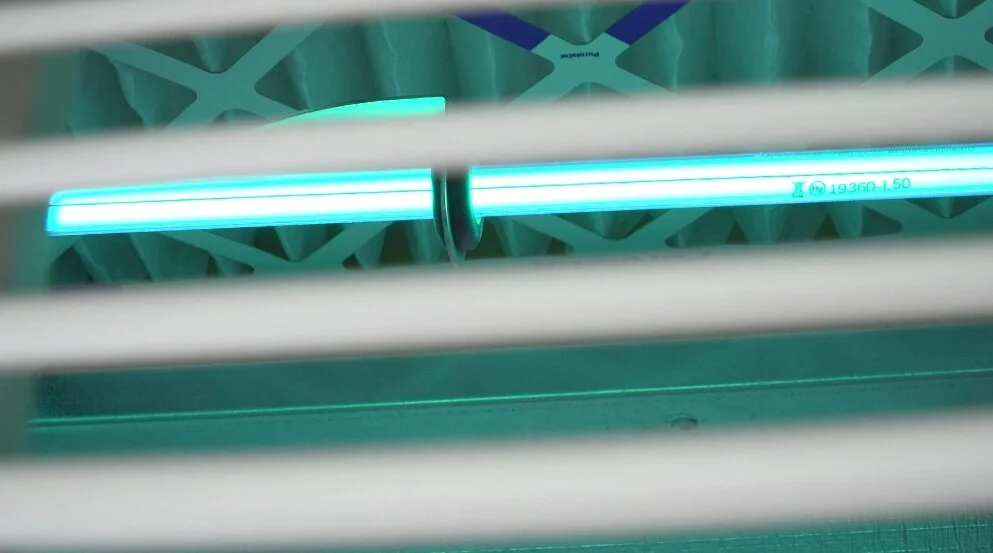How Do Ultraviolet (UV) Light Germicidal Air Purifiers Work?
Exposure to germs (those that cause disease- e.g. viruses, bacteria, mold spores) is a big concern in the world of public health. Airborne germ worries include methicillin-resistant Staphylococcus aureus (MRSA), the flu, bioterrorism, and other severe respiratory problems like severe acute respiratory syndrome (SARS). One solution long-utilized to combat airborne germ spread is by using ultraviolet germicidal irradiation (UVGI) air purifier — or more commonly referred to as a germicidal air purifier.
What Is Ultraviolet Light Germicidal Irradiation?
UVGI is a process in which airborne germs are killed off using ultraviolet light. The ultraviolet light disinfection rays come from special air purifiers or HVAC systems that don’t pose a risk to humans in the space in which the air is being purified.
A peer-reviewed science article written by Reed (2010) examined numerous studies conducted on the efficacy and safety of the use of ultraviolet light disinfection of germs in the air. The article concluded that if used correctly, UV light (specifically UV-C, which is a short wavelength) can be safe while at the same time being incredibly effective- thus helping to minimize the threat of airborne spread.
The UV germicidal air purifier system works by targeting the air within a space and exposing it to ultraviolet light. Once the harmful air contaminants receive enough UV energy, they remain in the air but are no longer harmful.
For cleaner air, book a free IAQ consultation or learn more about our commercial air purifiers.
As summarized by Reed, UV-C is a short wavelength UV (100-280 nm) within the UV spectrum. UV-C acts as a germicide by damaging the nucleic acids including deoxyribonucleic acid (DNA) and ribonucleic acid (RNA) of a germ. When the high-energy wavelength hits the DNA or RNA, it causes a mutation to form between the smaller bases that build the molecule of DNA or RNA. With this mutation to its DNA (or RNA in the cases of some viruses), the germ is unable to replicate (grow in population size), thus preventing its spread. Incorporation of UV-C into a building’s heating, ventilation, and air-conditioning (HVAC) systems is one way of cleaning the air of microbes. This is done by pulling the air using the HVAC system past the UV-C emitter. This is not always a straightforward install as the UVC emitter and the correct quantity of UVC emitters need to be applied properly to have the proper kill rate.
Most existing HVAC systems move the air at a rapid speed which makes getting the right exposure time on the germs harder to do and much more expensive due to the number of UVC emitters needed. Because of the challenges with properly applying a UV-C to an existing HVAC system, many facilities are turning to the use of UVC-equipped germicidal air purifiers which enables airspeed to slow down long enough for germs and viruses to be exposed to ultraviolet light.
Does UV Light Kill COVID-19?
In general, yes. It has been found that ultraviolet light disinfection can kill COVID-19 particles. Similar to COVID-19, other respiratory problems like severe acute respiratory syndrome (SARS), can also be killed off using UV germicidal air purifiers.
Ultraviolet light disinfection can significantly lower the risk of other airborne germs including methicillin-resistant Staphylococcus aureus (MRSA), the flu, bioterrorism, and more. UV-C has been utilized in schools, hospitals, and other locations with great success, and has been documented as a germicide since the 1930s.
Choose ISO-Aire UV Germicidal Air Purifiers to Protect Your Residential or Commercial Space
ISO-Aire has over 55 years of experience providing clean breathing air to residential and commercial spaces. Our UV germicidal air purifiers use a UVC bulb to destroy pathogens and reduce airborne transmission of diseases. Discover why you should choose ISO-AIre for your clean indoor air, compare ISO-Aire products, or contact us today to learn more about ultraviolet light disinfection.


